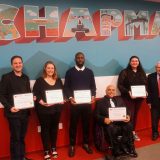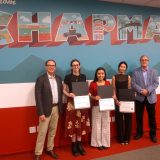My Librarian’s Favorite Resource(s): Engineering and Sciences
March 19, 2021
This week is our third installment of the “My Librarian’s Favorite Resource(s)” blog series. This week, we’re talking to Engineering, Sciences, and Digital Humanities librarian Doug Dechow, Ph.D. about the resources that he uses the most, and how he became the Sciences librarian at the Leatherby Libraries.
Doug writes, “I am privileged to be the current Engineering and Sciences librarian. In that role, I serve the faculty, students, and staff of the Schmid College of Science & Technology and Dale E. and Sarah Ann Fowler School of Engineering. Prior to becoming a librarian, I was a research computer scientist in a highly interdisciplinary field which required me to regularly collaborate with physicists and engineers. As a result of these experiences, my current role at Chapman University is an excellent fit for my skills and interests.
“I arrived on campus in 2008, two weeks prior to the beginning of the fall semester. Since that time, the university has founded the schools of science and engineering and completed their new home, the Keck Center for Science and Engineering. It’s been very exciting for me as a librarian to support the research and learning needs of our science and engineering faculty and students with increased access to the scientific literature. A couple of my favorite information resources for doing just that are Access Science and ScienceDirect. One new engineering resource that the Leatherby Libraries added this academic year is Optics InfoBase, and I’ve just started to become familiar with it.
“Access Science is a great place for students to begin their research for a class project. It’s essentially an online science encyclopedia. Recently, a number of classes have developed assignments and projects around topics related to the pandemic: coronavirus, COVID-19, and vaccines. The Access Science entry for coronaviruses gives students a high-level overview of the main features of the coronavirus family, and it contains a curated list of peer-reviewed sources—including a Journal of the American Medical Association (JAMA) article by Dr. Anthony Fauci—at the end of the article. The entries are written so that any undergraduate student, not just those in STEM fields, can read and learn from the articles.
“ScienceDirect is one of the largest, most comprehensive research databases that we make available in the Leatherby Libraries. I enjoy helping students and faculty learn how to use ScienceDirect. Every time that I use that database, I learn something new. ScienceDirect has a number of standout features, but two that are really being emphasized right now are Open Access articles and Topic Pages. Open Access publications are peer-reviewed articles that are freely available online without any barriers to access (such as subscribing to a particular database). ScienceDirect is currently making more than one-million peer-reviewed articles available via Open Access. Topic Pages are overviews of important concepts. ScienceDirect uses text analysis software to identify concepts that students might want background or reference information about. Those summaries are then inserted as links to the Topic word in the articles. They are great tool for enhancing a student’s reading of peer-reviewed articles by providing reference support for new or unfamiliar concepts.
“Optics InfoBase advertises itself as ‘the largest peer-reviewed collection of optics and photonics information in the world.’ We added this resource to support the research needs of our colleagues in Fowler School of Engineering, and I can’t wait to begin to dive into it further so that I have a better understanding of the kind of research and projects that our engineering faculty and students will be doing.”
In addition to serving as the Engineering and Sciences librarian, Doug is the co-author, with Creative Writing professor Anna Leahy, Ph.D., of Generation Space: A Love Story, and the co-author of The Craft of Librarian Instruction: Using Acting Techniques to Create Your Teaching Presence.



